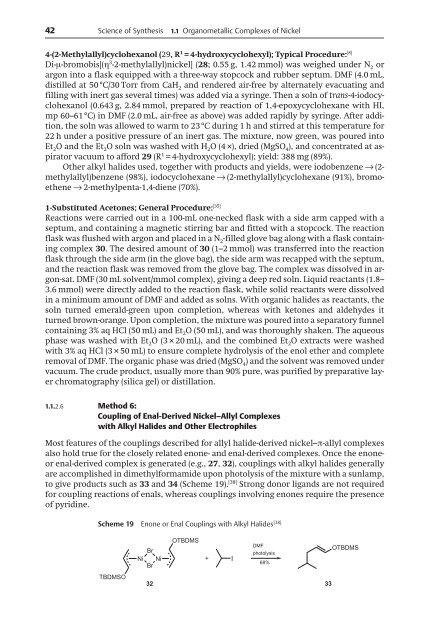You also want an ePaper? Increase the reach of your titles
YUMPU automatically turns print PDFs into web optimized ePapers that Google loves.
42 Science of Synthesis 1.1 Organometallic Complexes of Nickel<br />
4-(2-Methylallyl)cyclohexanol (29,R 1 = 4-hydroxycyclohexyl); Typical Procedure: [8]<br />
Di-ì-bromobis[(ç 3 -2-methylallyl)nickel] (28; 0.55 g, 1.42 mmol) was weighed under N 2 or<br />
argon into a flask equipped with a three-way stopcock and rubber septum. DMF (4.0 mL,<br />
distilled at 508C/30 Torr from CaH 2 and rendered air-free by alternately evacuating and<br />
filling with inert gas several times) was added via a syringe. Then a soln of trans-4-iodocyclohexanol<br />
(0.643 g, 2.84 mmol, prepared by reaction of 1,4-epoxycyclohexane with HI,<br />
mp 60–61 8C) in DMF (2.0 mL, air-free as above) was added rapidly by syringe. After addition,<br />
the soln was allowed to warm to 23 8C during 1 h and stirred at this temperature for<br />
22 h under a positive pressure of an inert gas. The mixture, now green, was poured into<br />
Et 2O and the Et 2O soln was washed with H 2O (4 ”), dried (MgSO 4), and concentrated at aspirator<br />
vacuum to afford 29 (R 1 = 4-hydroxycyclohexyl); yield: 388 mg (89%).<br />
Other alkyl halides used, together with products and yields, were iodobenzene fi (2methylallyl)benzene<br />
(98%), iodocyclohexane fi (2-methylallyl)cyclohexane (91%), bromoethene<br />
fi 2-methylpenta-1,4-diene (70%).<br />
1-Substituted Acetones; General Procedure: [35]<br />
Reactions were carried out in a 100-mL one-necked flask with a side arm capped with a<br />
septum, and containing a magnetic stirring bar and fitted with a stopcock. The reaction<br />
flask was flushed with argon and placed in a N 2-filled glove bag along with a flask containing<br />
complex 30. The desired amount of 30 (1–2 mmol) was transferred into the reaction<br />
flask through the side arm (in the glove bag), the side arm was recapped with the septum,<br />
and the reaction flask was removed from the glove bag. The complex was dissolved in argon-sat.<br />
DMF (30 mL solvent/mmol complex), giving a deep red soln. Liquid reactants (1.8–<br />
3.6 mmol) were directly added to the reaction flask, while solid reactants were dissolved<br />
in a minimum amount of DMF and added as solns. With organic halides as reactants, the<br />
soln turned emerald-green upon completion, whereas with ketones and aldehydes it<br />
turned brown-orange. Upon completion, the mixture was poured into a separatory funnel<br />
containing 3% aq HCl (50 mL) and Et 2O (50 mL), and was thoroughly shaken. The aqueous<br />
phase was washed with Et 2O (3 ” 20 mL), and the combined Et 2O extracts were washed<br />
with 3% aq HCl (3 ” 50 mL) to ensure complete hydrolysis of the enol ether and complete<br />
removal of DMF. The organic phase was dried (MgSO 4) and the solvent was removed under<br />
vacuum. The crude product, usually more than 90% pure, was purified by preparative layer<br />
chromatography (silica gel) or distillation.<br />
1.1.2.6 Method 6:<br />
Coupling of Enal-Derived Nickel–Allyl Complexes<br />
with Alkyl Halides and Other Electrophiles<br />
Most features of the couplings described for allyl halide-derived nickel–ð-allyl complexes<br />
also hold true for the closely related enone- and enal-derived complexes. Once the enoneor<br />
enal-derived complex is generated (e.g., 27, 32), couplings with alkyl halides generally<br />
are accomplished in dimethylformamide upon photolysis of the mixture with a sunlamp,<br />
to give products such as 33 and 34 (Scheme 19). [38] Strong donor ligands are not required<br />
for coupling reactions of enals, whereas couplings involving enones require the presence<br />
of pyridine.<br />
Scheme 19 Enone or Enal Couplings with Alkyl Halides [38]<br />
TBDMSO<br />
Br<br />
Ni Ni<br />
Br<br />
32<br />
OTBDMS<br />
+<br />
I<br />
DMF<br />
photolysis<br />
68%<br />
33<br />
OTBDMS
















